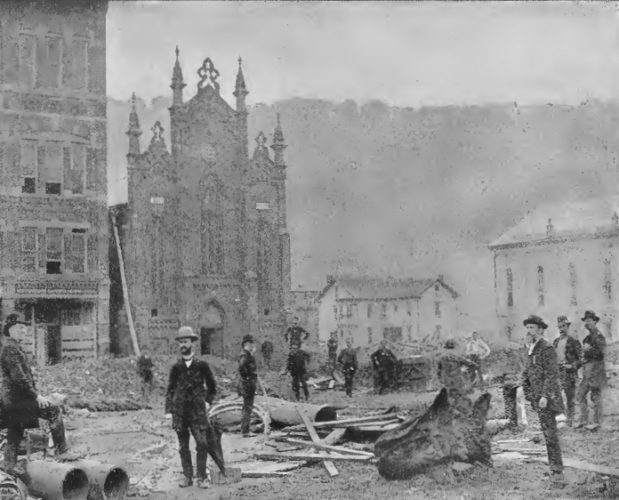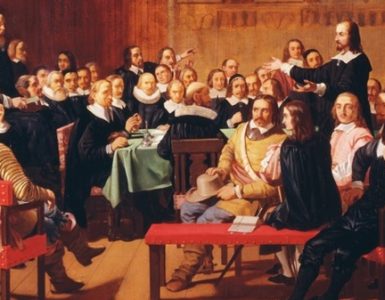 David was born the son of Joshua and Milly (Milliken) Beale July 1, 1835 in the village of Honey Grove which is located about forty-five miles west-northwest of Harrisburg, Pennsylvania. While David was a boy his father moved the household east to Mifflintown on the Juniata River. For academic studies David was a student at Tuscarora Academy and for spiritual fellowship and worship he attended the Lost Creek Presbyterian Church, Old School. Matthew Allison, an immigrant from Scotland, was David’s pastor when at the age of seventeen he professed faith in Christ.
David was born the son of Joshua and Milly (Milliken) Beale July 1, 1835 in the village of Honey Grove which is located about forty-five miles west-northwest of Harrisburg, Pennsylvania. While David was a boy his father moved the household east to Mifflintown on the Juniata River. For academic studies David was a student at Tuscarora Academy and for spiritual fellowship and worship he attended the Lost Creek Presbyterian Church, Old School. Matthew Allison, an immigrant from Scotland, was David’s pastor when at the age of seventeen he professed faith in Christ.
Beale graduated Jefferson College in Canonsburg in 1861, then in the fall he began ministerial studies in nearby Western Theological Seminary but left after only a semester. The reason for his brief attendance was not given. His next venue for divinity education was Princeton Seminary in New Jersey, but he did not complete the program there either. Despite not having a seminary certificate in hand, he was licensed April 16, 1863, by the Presbytery of Huntingdon, Old School, and supplied the pulpit of Middle Tuscarora Presbyterian Church until ordained and installed its pastor August 11, 1864. The small community had a sizeable congregation with 347 communicant members that needed his oversight, but Pastor Beale added to his ministry by supplying a mission in Peru Mills until it was organized in 1867. He left the state for the next two successive churches—the first call was for three years in St. George’s, Delaware, and the second was at the Light Street Church in Baltimore for eleven years ending September 3, 1883. Pastor Beale’s next ministry relocated him back across the Mason-Dixson Line in his Quaker State homeland.
When David Beale was installed by the Presbytery of Blairsville in the Johnstown church, October 10, 1883, he could not have imagined the part he would play in the city’s history. At the time he began the call, Johnstown was bustling with about 30,000 inhabitants and many of them worked for Cambria Iron Company. For the residents, noise, smoke, soot, and smells were a way of life. The Presbyterians enjoyed a good ministry among the residents with Pastor Beale’s congregation numbering nearly 400 members and an evangelist named David M. Miller was working to establish a second church. By 1888, Beale’s flock numbered 551 and Evangelist Miller’s efforts were blessed with seventy members organized in the Conemaugh Presbyterian Church. Johnstown was growing with hopes for a continued prosperous future and the Presbyterians were increasing their ministry.
The Conemaugh Valley could be a rainy place during the spring. It was not unusual for Johnstown to have some flooding, but the spring of 1889 was different because there were record setting showers “sent on the just and the unjust” (Matthew 5:45). Up the valley about fourteen miles from Johnstown was a private organization named the South Fork Hunting and Fishing Club located on Lake Conemaugh. Among its members were prosperous businessmen from the Pittsburgh area who frequented the retreat for cool weather in summer and outdoor recreation. The lake was man-made. Its restraining dam was in poor shape at the time of its sale to the South Fork developers. The weakened structure was shored up, patched, and worried about, but nothing was done to properly rectify the situation. It was not an issue of money; the prosperous club members could have financed a dam reconstruction project. To make matters worse, South Fork developers had removed the top three feet of the earthen dam to provide a carriageway so members could ride rather than walk to their homes on the other side of the lake.

On May 31, 1889 at about three in the afternoon, the dam breached pouring down the Conemaugh Valley a river of water that accelerated to forty miles per hour as it dropped 450 feet in elevation. It was said the roar of the water was deafening. If one could have stood on the side of a mountain looking at the flood careening down the valley it would have appeared as a four-story high foaming torrent carrying a variety of debris. It chewed up everything in its path. At the end of the flood’s route was Johnstown. Just before the dam failed, a concerned man had observed its weakened condition and telegraphed ahead, but when the message was received in the Johnstown Western Union office, it was ignored. It was a case of the boy who cried wolf syndrome; the residents of Johnstown had received warnings before but water never came down the valley, so there was no reason to think it would be any different this time. The telegraph office made a tragic mistake. When the water hit town, 1600 houses were washed away, trains were derailed, and over 2,200 people were killed. Ninety-nine families were wiped-out including nearly 400 children. Four square miles of downtown Johnstown were devastated. The Johnstown Flood is third in the list of worst natural disasters in American history behind the Galveston hurricane of 1900, and the catastrophic San Francisco earthquake and fire in 1906.
Pastor Beale was in the church manse with his family when the wall of water hit town. It seemed to him that the house was going to be washed away, so he directed the family to the third floor where they transferred to a more sturdy building next door. A daughter remembered to bring their canary in its cage. The Beales survived by God’s grace. Their little dog was rescued from the flood to remain the Beales’ best four-legged friend. The Presbyterian Church building survived with damage. Despite the poor condition of the church it was good enough to be used for one of the morgues needed for the many corpses. Johnstown had to recover and rebuild.
David Beale wanted to help his congregation and city recover. He was placed on the Morgue Committee. The committee had the necessary but difficult task of gathering and identifying bodies, notifying their kin, returning personal items, and then seeing the deceased were properly buried. In many cases bodies could not be identified. What a distressing situation for a minister as he directed handling the dead in the light of eternity. As the city recovered, one resident, Alexander N. Hart, while telling of his own experience commented regarding Beale’s work.
I cannot end this account without paying tribute to Dr. David J. Beale, the pastor of the Presbyterian Church. During the whole time of the flood and afterward, he forgot himself in his care and ministering to us and our suffering people. Throughout that dreadful night in Alma Hall, he was incessant in his attentions, though his own wife and children were among the suffering multitude. By his kind, consoling words, by his calmness and self-control, by his fervent prayers, directing us to our only help in this time of trouble, he made it possible for us to endure the horrors of that night. During the following weeks his work and services in the morgues and among the survivors have laid our citizens under obligations they can never fully discharge. (Through the Flood, p. 347)
Like George D. Armstrong, whose The Summer of the Pestilence, 1856, provides an account of a yellow fever epidemic in Norfolk, Virginia, David Beale’s Through the Flood, By a Survivor, 1890, gives an eyewitness and informative record of the Johnstown Flood. His book includes a detailed list of those that died in the flood.
David Beale’s call to Johnstown was dissolved by the Presbytery of Blairsville September 16, 1890, so he could transfer to the church in Frederick City, Maryland, where he remained until July 1896. Returning to Pennsylvania, this time Philadelphia, his last pastoral call was to First Church of the Northern Liberties for two years ending October 3, 1898. When he passed away from what was diagnosed as angina pectoris October 19, 1900, he had been involved in an evangelism ministry. David J Beale was married on May 2, 1865, to Mary Riddle Moore in Bellefonte, Pennsylvania. She survived him along with their three sons and three daughters. He was buried in the Presbyterian Cemetery in Mifflintown, Pennsylvania.
Dr. Beale was a Member of the American Academy of Political and Social Science, and he was honored with the Doctor of Divinity in 1886 by Washington and Jefferson College, his alma mater had merged with Washington College in 1865. In addition to his important account of the Johnstown Flood and its aftermath, Beale wrote The History of the Tuscarora Valley, 1869; Sketches of the Jefferson College Class of 1861, 1886; Life and Labors of Professor David Wilson, [n.d.]; and some sermons. The digitized copy of Beale’s book about the Johnstown Flood used for writing this post was scanned from one donated to Princeton Seminary by Wilson Thomas Moore Beale, David’s son, who graduated the seminary in 1902.
Barry Waugh
Notes—The header shows from left to right Alma Hall, the Disciples’ Church, the manse where the Beales lived, and the Presbyterian Church. All the images are from Beale’s book on the Johnstown Flood. I could not find out for certain what the “J” stands for in Beale’s name (note the lack of a period). One newspaper obituary says his middle name was Joshua, which means he may have been named for his father, or the obituary author assumed the J stood for Joshua. The Necrological Report for Princeton Seminary says the “J” was not an initial, just a “J.” Necrological Reports were composed from a data form provided by the graduate or a member of his family, so it is likely his middle name was just the letter. Sometimes parents gave their children middle initials, and this may be the case for Beale. Honey Grove, Pennsylvania, was at the time of Beale’s birth named Bealetown, which means there may have been other David Beales living there and his “J” was simply a practical way to distinguish him from other like-named residents. See on this site the explanation of the X in D. X Junkin’s name. The Junkin post also provides information regarding the considerable number of students who failed to complete their seminary educations but were licensed and ordained, as was the case with Beale. Information about Beale’s ministry in locations other than Jamestown was found in The Historical Memorial of the Centennial Anniversary of the Presbytery of Huntingdon Held in Huntingdon, PA., April 9, 1895 Published by the Authority of the Presbytery, 1795-1895, Philadelphia: J. B. Lippincott Co., 1896.





